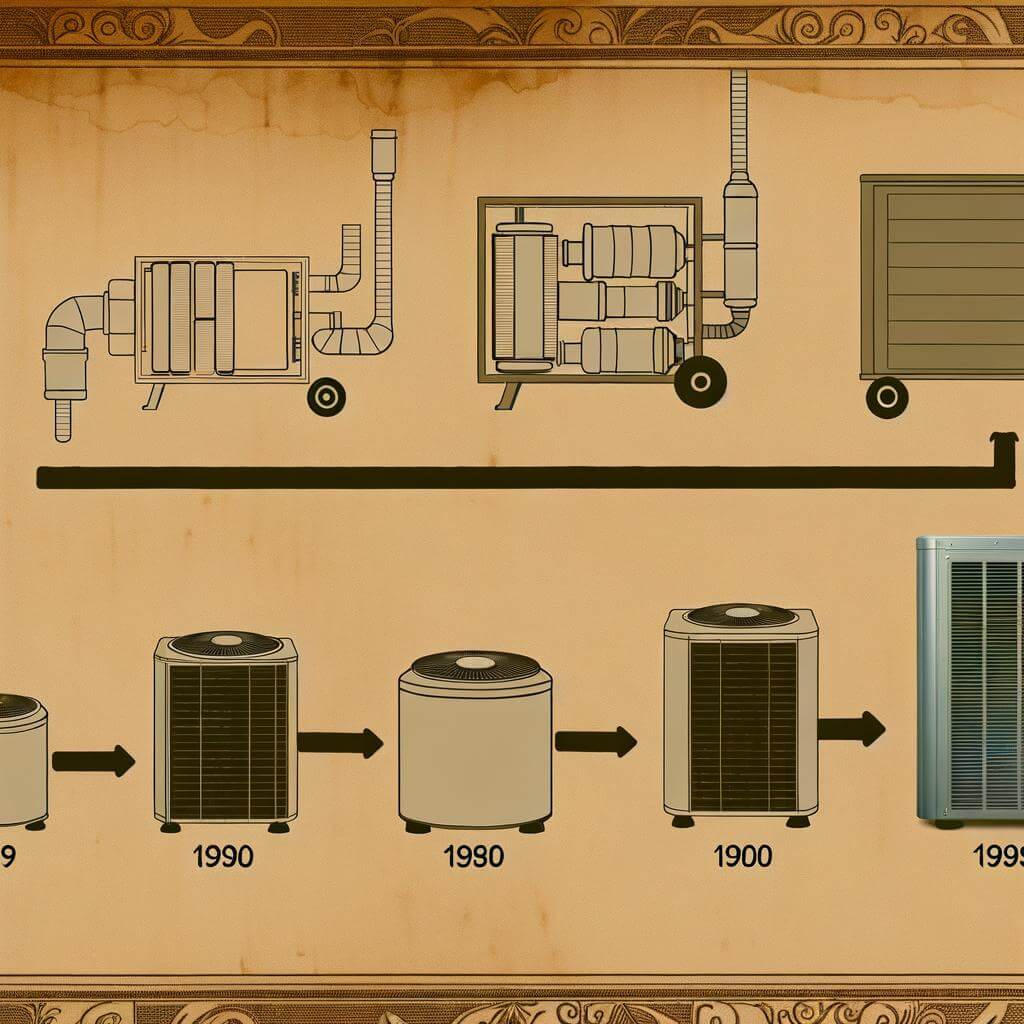Who knew that behind the crucial luxury of chilling out on a scorching hot day, there’s an unsung hero called the central air conditioning unit? It’s like a dutiful gnome, unbeknownst to us, humdrumming its way to keeping us sweat-free. In the background, it cranks out torrents of cold air, ensuring its inhabitants are immersed in an oasis of cool amidst sweltering summers. But how exactly does this wonder of cooling mastery work? Brace yourself for a journey through chilling tales, literally! In this article, we’ll take a dive into the world of the central AC units. We’re dishing out the ABCs of this crucial machine, unraveling the cool science behind it. Prepare to be blown away!

Understanding the Basic Mechanism of Central AC Units
The beauty of a central AC unit lies within its functionality. With the primary function being to cool and dehumidify a house or building, it uses a basic yet efficient mechanism to achieve this goal. Central AC units primarily consist of two major components: the condenser and the evaporator. They communicate through a refrigerant, a molecule capable of absorbing and releasing heat.
The condenser unit, typically located on the outside of the building, houses three important parts – the compressor, the condenser fan, and the condenser coils. Precisely, the compressor’s role is to compile the refrigerant gas inducing a rise in temperature and pressure. The increased pressure gas then moves into the condenser coils where the surrounding outside air absorbs the heat from the refrigerant, transforming it into a liquid. The condenser fan aids in expelling the resultant heat into the outside air.
Moving on to the indoor unit, the evaporator is the self-elected worker here. As a liquid, the refrigerant courses into the evaporator coils. It is here that the refrigerant again becomes gas as the surrounding air absorbs the heat and humidity, thus leaving cool and dehumidified air in its wake. The cool air is then disseminated across the house or building via air ducts and vents.
table, th, td {
border: 1px solid black;
border-collapse: collapse;
}
| Component | Function |
|---|---|
| Compressor | Compiles refrigerant gas inducing a rise in temperature and pressure |
| Condenser Coils | Refrigerant transforms into liquid as heat is expelled to the outside air |
| Evaporator Coils | Refrigerant becomes gas as the indoor air absorbs the heat, leaving cool and dehumidified air |
The combination of evaporation, condensation, compression, and expansion creates a cooling effect akin to how our bodies sweat to cool down in hot temperatures. As such, central AC units can efficiently regulate temperature and improve air quality creating a comfortable indoor environment.

Diving into the Design Evolution of Modern AC Systems
In the realm of home comfort, air conditioning systems have undergone significant transformations. The rudimentary methods of chilling air, which primarily relied on block ice and fans, have given way to modern high-tech cooling solutions. Interestingly, Willis Carrier, known as the father of modern air conditioning, conceived the idea of air conditioning systems in 1902, primarily to solve issues related to humidity affecting paper quality in a publishing company. This singular idea has given birth to the state-of-the-art central cooling systems that we enjoy today.
- Evaporator Coil: This part of the system absorbs heat from the surrounding air.
- Compressor: This crucial component pushes refrigerant through the system.
- Condenser Coil: It dissipates gathered heat and prepares the refrigerant for cycling back into the home.
- Air Handling Unit: It regulates and circulates air within the HVAC system, ensuring efficient cooling.
As technical advancements have paved the way for improved design, many modern AC systems now come with smart features. Currently, you can control temperature settings remotely through mobile apps, and some units can even learn your behavior to ensure optimal temperature and energy use. Energy efficiency has also improved drastically over the years. For instance, a table comparison of AC units from different decades would reveal staggering energy efficiency improvements:
| Decades | Energy Efficiency (SEER)* |
|---|---|
| 1980s | 8 |
| 1990s | 10 |
| 2000s | 13 |
| 2010s | 20 |
*SEER (Seasonal Energy Efficiency Ratio) indicates an air conditioner’s cooling efficiency. The higher the SEER rating, the more energy-efficient the unit.
Indeed, the air conditioner’s journey is one of constant evolution – refining its operation, integrating itself with technology, and offering unparalleled comfort with lesser environmental impacts. Even as we bask in the cool breeze of our current systems, design and engineering minds are continuously working on the next big breakthrough in cooling technology.

Analyzing the Significance of Regular Maintenance for AC Units
The significance of regular maintenance for central AC units cannot be overstated or underrated. Like a well-oiled automobile, your central AC unit needs regular check-ups, servicing, and repairs to keep it running at its optimum performance. Failure to do so may lead to numerous complications. With regular maintenance, you significantly reduce the risk of sudden malfunctions, enhance efficiency, save on cost, and prolong the lifespan of your unit. Essential AC upkeep includes tasks like cleaning or replacing filters, inspecting for leaks, and assessing the overall operation of the system.
Benefits of Regular Maintenance for AC Units
- Improved Efficiency: Over time, AC components gather dust and debris, which interfere with their functionality, leading to increased energy consumption. Regular maintenance helps to forestall this, enabling smooth operations and reducing your energy bills.
- Less Emergency Repairs: Sudden AC breakdowns can be quite inconvenient, especially during extreme weather conditions. Concrete maintenance plans help identify potential issues early, saving you from unexpected repairs and discomfort.
- Durability: Regular maintenance can extend the lifespan of your AC, helping you to get the most out of your investment.
| Task | Frequency |
|---|---|
| Clean or Replace Filters | Every 1-2 months |
| Inspect for Refrigerant Leaks | At least once a year |
| Check System Controls | Bi-annually |
| Clean Evaporator and Condenser Coils | Annually |
Undoubtedly, regular AC maintenance offers significant benefits. It is a practical and cost-effective strategy that ensures your unit provides the cooling efficiency you need when you need it most. Moreover, a properly maintained unit will use less energy and have a significantly longer lifespan.

Decoding the Energy Efficiency of Central AC Units
Cooling your house through the blistering summer months is no small feat. A central AC unit works tirelessly, churning out cold air to keep you comfortable. However, not all AC units are created equal. Finding an energy-efficient model can significantly reduce your electricity bills. With a bit of knowledge about what makes an AC unit efficient, you can make an informed decision when buying a new one or upgrading your existing system.
To understand the energy efficiency of central AC units, two key terms you should be familiar with are SEER and EER. SEER (Seasonal Energy Efficiency Ratio) measures the cooling efficiency of your AC unit over an entire cooling season. On the other hand, EER (Energy Efficiency Ratio) represents its cooling capabilities at a fixed temperature. By comparing these ratios, you can measure the performance and energy efficiency of different AC units.
- Higher SEER & EER – Indicates a more energy-efficient unit, which translates to lower power bills.
- Lower SEER & EER – Means that the unit consumes more energy to cool the same space, leading to higher electricity bills.
| AC Units (Manufacturer) | SEER | EER |
|---|---|---|
| ABC Central AC | 16 | 12.5 |
| DEF Central AC | 14.5 | 11.5 |
| GHI Central AC | 15 | 11 |
| AC Units (Manufacturer) | SEER | EER |
So, next time you’re in the market for a central AC unit, remember to check the SEER and EER ratings. The higher the number, the better the energy efficiency!

Breathtaking Cooling Power: The Silent Warrior against Heat
Relaxation takes a new form during the hot summer months, and that’s where our powerful yet cryptically quiet warrior joins the scene. With too much heat being a recipe for discomfort, there’s an unsung hero lurking conveniently within your walls, working tirelessly to maintain that perfect seeming ambient temperature around your home. Yes, we’re referring to your central air conditioning (AC) unit, that monitor of tranquillity and whispering soldier against the relentless heat.
Let’s take capacity into consideration first. The job of an AC unit is indeed to chill your house, but not all AC units have the same capacity to cool. Capacity is typically measured in tons, where one ton equals the cooling effect of 12,000 British Thermal Units (BTUs) per hour. A bigger home would need a unit with a higher tonnage, and vice versa. Andy yet, size isn’t all that matters when it comes to perfect cooling. Here is another critical element:
| Element | Description |
|---|---|
| SEER Rating | SEER (Seasonal Energy Efficiency Ratio) tells us about the cooling efficiency of the AC unit. A high SEER rating denotes a more efficient unit. |
Don’t underestimate the importance of this factor. While a higher SEER rating may come with a steeper price tag, it can significantly lower your energy bills in the long run, making this warrior not only strong but smart. In the battle against heat, the victory belongs to those who understand that prowess is not always about sheer power, but strategy too!

Gear Up for Summer: Selecting the Right AC Unit for your Space
As the mercury rises, the battle to keep your homes cool begins. Finding the right air conditioning unit becomes a top priority, and the decision isn’t always as ‘cool’ as one may think. With a myriad of options available, you need to find an AC unit that not only meets your cooling needs but is also energy-efficient and cost-effective. Central AC units often emerge as the popular choice for many homeowners, providing them the ability to regulate the temperature of their entire house seamlessly. Let’s discuss the intricacies and features of these powerful cooling machines to make the right choice this summer. A Central AC unit operates by extracting heat from the indoor air and expelling it outside, thereby cooling down your house. The key factors that come into play while deciding on the right AC unit comprise the size of your living space, the average local climate, and your budget. Here are some crucial details to consider:
- AC Unit Size: It’s imperative to pick the right size. An overly-sized unit will cool the space quickly but won’t effectively reduce humidity, leaving a damp environment. Conversely, a small unit will struggle to cool larger spaces, leading to increased energy consumption.
- Energy Efficiency: Today’s models come with high energy-efficiency ratios (EER). Selecting a unit with a higher EER will be pricier upfront, but it will lead to long-term savings on energy bills.
- Installation & Maintenance: It would be best if you ensure that the unit is professionally installed, offering comprehensive maintenance and repair services.
| AC Unit Size | Recommended for |
|---|---|
| Small (up to 5,000 BTU) | 150 sq. ft. (room: bedroom, office) |
| Medium (5,000-12,000 BTU) | 450 sq. ft. (apartment: living room) |
| Large (12,000-20,000 BTU) | 1,000 sq. ft. (house: multiple rooms) |




